

For you. Free Ubuntu Linux E-Books If you're new here, you may want to subscribe to my RSS feed and if you have questions related to your ubuntu system post question to our forums.

Thanks for visiting! Sponsored Link If you are ubuntu user and if you are looking for some ubuntu related books for free check this Book Title: Moving to Ubuntu Linux By Marcel Gagné Publisher: Addison Wesley Professional Brief Introduction Discover Ubuntu, Today's Hottest Linux Everyone's talking about Ubuntuit's not just 100% free, it's the most useful, practical desktop Linux ever! Karl Fogel. San Francisco’s Enterprise Addressing System Is Now Open Source! We’re pleased to announce that San Francisco’s Enterprise Addressing System has now been open sourced!
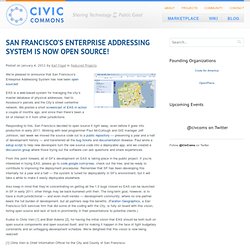
EAS is a web-based system for managing the city’s master database of physical addresses, tied to Assessor’s parcels and the City’s street centerline network. We posted a short screencast of EAS in action a couple of months ago, and since then there’s been a lot of interest in it from other jurisdictions. Responding to this, San Francisco decided to open source it right away, even before it goes into production in early 2011. Working with lead programmer Paul McCullough and GIS manager Jeff Johnson, last week we moved the source code out to a public repository — preserving a year and a half of development history — and transferred all the bug tickets and documentation likewise. Paul wrote a setup script to help new developers turn the raw source code into a deployable app, and we created a discussion group where those trying out the software can ask questions and share experiences. Data Visualization Platform, Weave, Now Open Source. With more and more civic data becoming available and accessible, the challenge grows for policy makers and citizens to leverage that data for better decision-making.
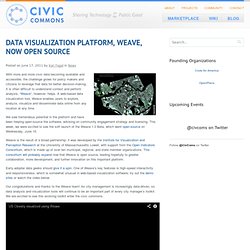
It is often difficult to understand context and perform analysis. “Weave”, however, helps. A web-based data visualization tool, Weave enables users to explore, analyze, visualize and disseminate data online from any location at any time. We saw tremendous potential in the platform and have been helping open-source the software, advising on community engagement strategy and licensing. This week, we were excited to see the soft launch of the Weave 1.0 Beta, which went open-source on Wednesday, June 15. Zanby.com. Sharing Technology for the Public Good. Write or Call the White House. President Obama is committed to creating the most open and accessible administration in American history.
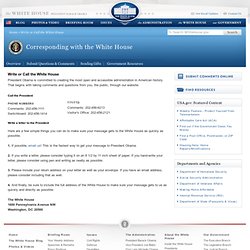
That begins with taking comments and questions from you, the public, through our website. Call the President Phone Numbers. Startup America Policy Challenge. The central platform for crowdsourcing US Government challenges, contests, competitions and open innovation prizes. Open Government Initiative. Open Data Policy Guidance to better manage Federal information as an asset to make it more open, accessible, and usable by the public.
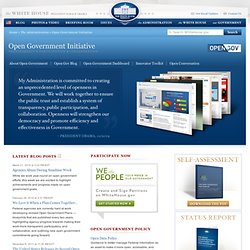
Executive Order on Making Open and Machine Readable the New Default for Government Information The President’s Executive Order on making Federal Government information more open and accessible to promote economic growth and government efficiency. National Action Plan for the United States of America. Wiki Government. Collaborative democracy—government with the people—is a new vision of governance in the digital age.
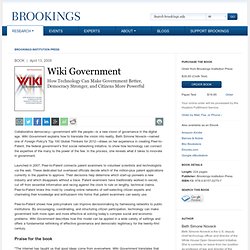
Wiki Government explains how to translate the vision into reality. Beth Simone Noveck—named one of Foreign Policy's Top 100 Global Thinkers for 2012—draws on her experience in creating Peer-to-Patent, the federal government’s first social networking initiative, to show how technology can connect the expertise of the many to the power of the few. In the process, she reveals what it takes to innovate in government. Launched in 2007, Peer-to-Patent connects patent examiners to volunteer scientists and technologists via the web.
These dedicated but overtaxed officials decide which of the million-plus patent applications currently in the pipeline to approve. Beth Noveck: Transparent Government. President Obama's first executive action was the Open Government Memorandum calling for more transparent, participatory, and collaborative government.

It is likely that one of the longest lasting effects of the current administration will be how much it changed the culture of Washington by opening government data and pioneering innovations in policymaking. As the United States Deputy Chief Technology Officer and leader of the President's Open Government Initiative in the White House, Beth Noveck is in the forefront of the Federal government's implementation of these changes. On leave as law professor at New York Law School and a visiting professor of communication at Stanford University, she lectures on intellectual property, innovation and technology law.
She is also the Founder of the State of Play conferences. Open Government Initiative Blog. Beth Simone Noveck. Beth Simone Noveck was the United States deputy chief technology officer for open government and led President Obama's Open Government Initiative.
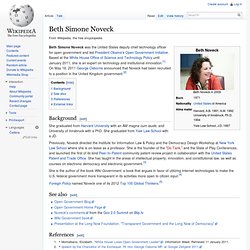
Based at the White House Office of Science and Technology Policy until January 2011, she is an expert on technology and institutional innovation.[1] On May 16, 2011 George Osborne announced that Noveck had been recruited to a position in the United Kingdom government.[2] Background[edit] She graduated from Harvard University with an AM magna cum laude, and University of Innsbruck with a PhD. She graduated from Yale Law School with a JD. Previously, Noveck directed the Institute for Information Law & Policy and the Democracy Design Workshop at New York Law School where she is on-leave as a professor.
She is the author of the book Wiki Government, a book that argues in favor of utilizing Internet technologies to make the U.S. federal government more transparent in its activities more open to citizen input.[4] See also[edit] References[edit] Open Government - Resolution of Canada’s Access to Information and Privacy Commissioners, September 1, 2010, Whitehorse, Yukon. Resolution of Canada’s Access to Information and Privacy Commissioners September 1, 2010, Whitehorse, Yukon Calls for greater openness and transparency are exerting increasing pressure on governments to transform their traditional, reactive information dissemination methods into a mode that facilitates proactive disclosure.
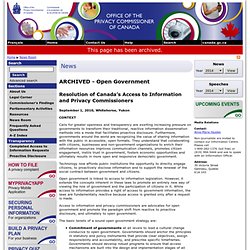
Furthermore, governments around the world are recognizing the value of sharing information with the public in accessible, open formats. Open Government Innovation. Helping to shape the future of government. Helping cities work better. What is Open311? Open311 is a form of technology that provides open channels of communication for issues that concern public space and public services.

Primarily, Open311 refers to a standardized protocol for location-based collaborative issue-tracking. By offering free web API access to an existing 311 service, Open311 is an evolution of the phone-based 311 systems that many cities in North America offer. Unlike the synchronous one-to-one communication of a 311 call center, Open311 technologies use the internet to enable these interactions to be asynchronous and many-to-many. This means that several different people can openly exchange information centered around a single public issue. This open model allows people to provide more actionable information for those who need it most and it encourages the public to be engaged with civic issues because they know their voices are being heard. GCF09_brochure.pdf (application/pdf Object) Life in the Cloud: Introducing Government as a Service.
With all the talk of cloud computing with in the U.S. Federal Government lately, it seems to be rubbing off on other governments around the globe. I've recently had conversations with the Canadian, US, UK, UN, and EU governments asking about how they might be able to investigate the creation of "public cloud computing infrastructures" for both governmental use as well as for their citizens. I'm calling this new movement toward the governmental adoption of cloud computing -- Government as a Service.
Simply Government as a Service is a way for governments around the globe to offer enabling technical services to their population. These could be as simple as web based services to complex infrastructure and platforms made available through the web and specifically to a citizen of a given country. -- Update --Giving credit where credit is due, it looks like Alexis Richardson beat me to the term. Citizen CRM 2.0 – Open Government, as a Service « Level 5 Consulting. Recently the City of Ottawa released an RFP for a Citizen Service Management (CSM) solution that can unite all of their service departments into a consistent customer experience. Citizen CRM 2.0 Like most large organizations the city operates an estate of legacy applications to provide services like permits, licencing, police enforcement dispatch and incident tracking, maintenance scheduling and so forth, and they want to provide a singuar user interface to these via 311 call centres, web sites, kiosks, counters, emails, mobile other access channels for their residents.
This is a significant technology challenge. The legacy estate features major applications like SAP for the bulk of their ERP needs, which runs on a Solaris/Oracle platform, and then also each of the smaller departments typically runs their own dedicated software package for their particular business process needs, whether that be the parks inventory or property listings. Each needs integrated into this environment.